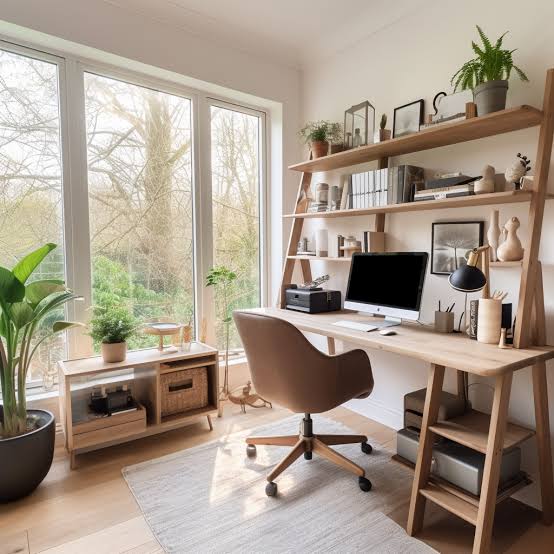
In today’s remote work environment, having a cozy home office isn’t just a luxury—it’s a necessity. A well-designed workspace can significantly enhance productivity and well-being. Here are some essential elements to consider when creating a comfortable and inviting home office.
1. Ergonomic Furniture
The cornerstone of a cozy home office is ergonomic furniture. Investing in a high-quality chair that supports good posture is crucial. Look for chairs with adjustable heights, lumbar support, and cushioning to ensure comfort during long working hours. Pair your chair with a desk at the right height to prevent strain on your wrists and shoulders. An ergonomic setup reduces physical discomfort and helps maintain focus throughout the day.
2. Optimal Lighting
Lighting plays a pivotal role in creating a comfortable workspace. Natural light is ideal as it boosts mood and productivity. Position your desk near a window to take advantage of daylight. For tasks requiring detailed work, invest in adjustable desk lamps that reduce eye strain and illuminate your workspace without causing glare. Warm, soft lighting can make the space more inviting and reduce the harshness of fluorescent lights.
3. Personal Touches
Adding personal touches to your home office can make it feel more inviting. Incorporate elements that reflect your personality and interests, such as artwork, plants, or photographs. A few well-chosen decorations can make the space feel more like your own and less like a generic workspace. Personalization helps create a positive association with your office, making it a place where you feel comfortable and motivated.
4. Functional Layout
A well-thought-out layout enhances comfort and efficiency. Arrange your furniture to facilitate easy movement and access to essential items. Your desk should be positioned to minimize glare from windows and reduce distractions. Keep frequently used items within arm’s reach to avoid unnecessary stretching or straining. Ensure there’s ample storage to keep your workspace clutter-free, as a tidy office contributes to a more relaxed atmosphere.
5. Climate Control
Maintaining a comfortable temperature is essential for a cozy home office. To achieve this, consider investing in high-quality heating or cooling systems tailored to the season. Additionally, proper ventilation is crucial—make sure your workspace has adequate airflow to avoid stuffiness. For those in Draper, reliable AC repair services can help ensure your climate control systems are functioning optimally. A well-regulated temperature not only boosts productivity but also supports your overall well-being while you work.
6. Acoustic Considerations
Noise can be a significant distraction in a home office. To create a serene environment, consider using noise-canceling headphones or adding soundproofing elements like acoustic panels or rugs. If possible, choose a room with minimal external noise. Soft background music or white noise can also help mask disruptive sounds and improve concentration.
7. Organizational Solutions
Effective organization contributes to a comfortable workspace. Invest in storage solutions such as shelves, filing cabinets, and desk organizers to keep your office tidy. A well-organized space reduces stress and makes it easier to find important documents or tools. Use cable management solutions to keep cords and cables neatly arranged, preventing tangles and creating a cleaner look.
8. Comfort Accessories
Enhance your home office with comfort accessories that make your workspace more enjoyable. Consider adding a plush rug or a comfortable throw blanket to your favorite type of office chair. A footrest can improve posture and reduce leg fatigue. Additionally, having a small, comfortable sofa or armchair can provide a relaxing spot for breaks or brainstorming sessions.
9. Aesthetics and Color Scheme
The aesthetic appeal of your home office can impact your mood and productivity. Choose a color scheme that promotes relaxation and focus. Soft, neutral colors like blues, greens, and grays create a calming environment, while brighter accents can add energy and vibrancy. Select furniture and decor that complement your chosen colors to create a cohesive and visually pleasing workspace.
10. Accessibility and Tech Setup
Ensure your office setup accommodates your technological needs. Position your computer screen at eye level to reduce neck strain and use a keyboard and mouse that are comfortable for extended use. Organize cables and chargers with the help of network cabling services to keep your workspace tidy and functional. A well-organized tech setup not only improves efficiency but also contributes to a more comfortable work environment.
In Conclusion
Designing a cozy home office involves more than just picking out furniture. It’s about creating a space where you feel comfortable, focused, and inspired. By paying attention to ergonomic furniture, lighting, personal touches, layout, climate control, acoustics, organization, comfort accessories, aesthetics, and tech setup, you can craft a home office that enhances both your productivity and well-being. With thoughtful design, your home office can become a place where work feels more enjoyable and less like a chore.
